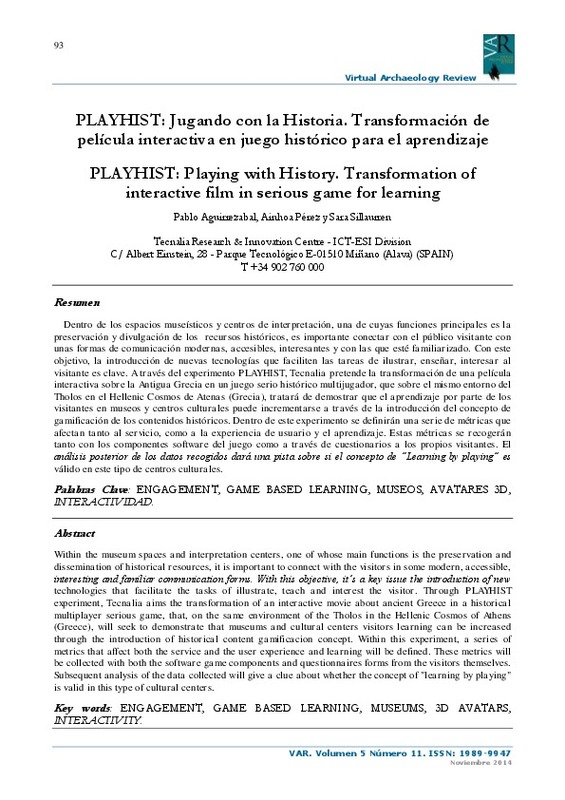JavaScript is disabled for your browser. Some features of this site may not work without it.
Buscar en RiuNet
Listar
Mi cuenta
Estadísticas
Ayuda RiuNet
Admin. UPV
PLAYHIST: Jugando con la Historia. Transformación de película interactiva en juego histórico para el aprendizaje
Mostrar el registro sencillo del ítem
Ficheros en el ítem
| dc.contributor.author | Aguirrezabal, Pablo
|
es_ES |
| dc.contributor.author | Pérez, Ainhoa
|
es_ES |
| dc.contributor.author | Sillaurren, Sara
|
es_ES |
| dc.date.accessioned | 2020-03-10T07:34:06Z | |
| dc.date.available | 2020-03-10T07:34:06Z | |
| dc.date.issued | 2014-11-23 | |
| dc.identifier.uri | http://hdl.handle.net/10251/138618 | |
| dc.description.abstract | [ES] Dentro de los espacios museísticos y centros de interpretación, una de cuyas funciones principales es la preservación y divulgación de los recursos históricos, es importante conectar con el público visitante con unas formas de comunicación modernas, accesibles, interesantes y con las que esté familiarizado. Con este objetivo, la introducción de nuevas tecnologías que faciliten las tareas de ilustrar, enseñar, interesar al visitante es clave. A través del experimento PLAYHIST, Tecnalia pretende la transformación de una película interactiva sobre la Antigua Grecia en un juego serio histórico multijugador, que sobre el mismo entorno del Tholos en el Hellenic Cosmos de Atenas (Grecia), tratará de demostrar que el aprendizaje por parte de los visitantes en museos y centros culturales puede incrementarse a través de la introducción del concepto de gamificación de los contenidos históricos. Dentro de este experimento se definirán una serie de métricas que afectan tanto al servicio, como a la experiencia de usuario y el aprendizaje. Estas métricas se recogerán tanto con los componentes software del juego como a través de cuestionarios a los propios visitantes. El análisis posterior de los datos recogidos dará una pista sobre si el concepto de “Learning by playing” es válido en este tipo de centros culturales. | es_ES |
| dc.description.abstract | [EN] Within the museum spaces and interpretation centers, one of whose main functions is the preservation and dissemination of historical resources, it is important to connect with the visitors in some modern, accessible, interesting and familiar communication forms. With this objective, it’s a key issue the introduction of new technologies that facilitate the tasks of illustrate, teach and interest the visitor. Through PLAYHIST experiment, Tecnalia aims the transformation of an interactive movie about ancient Greece in a historical multiplayer serious game, that, on the same environment of the Tholos in the Hellenic Cosmos of Athens (Greece), will seek to demonstrate that museums and cultural centers visitors learning can be increased through the introduction of historical content gamificacion concept. Within this experiment, a series of metrics that affect both the service and the user experience and learning will be defined. These metrics will be collected with both the software game components and questionnaires forms from the visitors themselves. Subsequent analysis of the data collected will give a clue about whether the concept of "learning by playing" is valid in this type of cultural centers. | es_ES |
| dc.language | Español | es_ES |
| dc.publisher | Universitat Politècnica de València | es_ES |
| dc.relation.ispartof | Virtual Archaeology Review | es_ES |
| dc.rights | Reconocimiento - No comercial - Sin obra derivada (by-nc-nd) | es_ES |
| dc.subject | Engagement | es_ES |
| dc.subject | Game based learning | es_ES |
| dc.subject | Museums | es_ES |
| dc.subject | 3D avatars | es_ES |
| dc.subject | Interactivity | es_ES |
| dc.subject | Museos | es_ES |
| dc.subject | Avatares 3D | es_ES |
| dc.subject | Interactividad | es_ES |
| dc.title | PLAYHIST: Jugando con la Historia. Transformación de película interactiva en juego histórico para el aprendizaje | es_ES |
| dc.title.alternative | PLAYHIST: Playing with History. Transformation of interactive film in serious game for learning | es_ES |
| dc.type | Artículo | es_ES |
| dc.identifier.doi | 10.4995/var.2014.4186 | |
| dc.rights.accessRights | Abierto | es_ES |
| dc.description.bibliographicCitation | Aguirrezabal, P.; Pérez, A.; Sillaurren, S. (2014). PLAYHIST: Jugando con la Historia. Transformación de película interactiva en juego histórico para el aprendizaje. Virtual Archaeology Review. 5(11):93-100. https://doi.org/10.4995/var.2014.4186 | es_ES |
| dc.description.accrualMethod | OJS | es_ES |
| dc.relation.publisherversion | https://doi.org/10.4995/var.2014.4186 | es_ES |
| dc.description.upvformatpinicio | 93 | es_ES |
| dc.description.upvformatpfin | 100 | es_ES |
| dc.type.version | info:eu-repo/semantics/publishedVersion | es_ES |
| dc.description.volume | 5 | es_ES |
| dc.description.issue | 11 | es_ES |
| dc.identifier.eissn | 1989-9947 | |
| dc.relation.pasarela | OJS\4186 | es_ES |
| dc.description.references | E.F. ANDERSON, L. MCLOUGHLIN, F. LIAROKAPIS, C. PETERS, P. PETRIDIS, S. DE FREITAS. 2010. Developing Serious Games for Cultural Heritage: A State-of-the-Art Review. Article published in Virtual Reality 14(4), 2010.(available from http://dx.doi.org/10.1007/s10055-010-0177-3) | es_ES |
| dc.description.references | NIKOLAOS AVOURISs. 2011. Learning through Games in Museums. European Conference on Game Based Learning (ECGBL 20115th). | es_ES |
| dc.description.references | Roma Nova project. http://www.irit.fr/~David.Panzoli/romanova.html ] | es_ES |
| dc.description.references | FRISCHER, B., 2008. "The Rome Reborn Project. How Technology is helping us to study history," OpEd, November 10, 2008. University of Virginia | es_ES |








